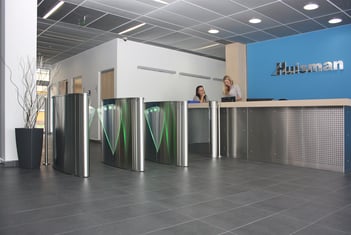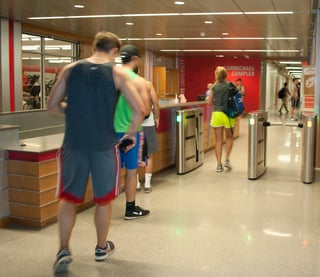We recently sat down with Boon Edam's Senior Vice President of Sales, Greg Schreiber. Greg has more than 30 years in the entrance market, and he spends many weeks during the year on the road, listening to customers and installers, and keeping up to date on trends and where the market is headed. Here are some hot topics we put to Greg for his thoughts.
Security Challenges for Schools and Colleges
Q: Safety in places of learning is never far from teachers and administrators’ minds given how many incidents we’ve had to witness. At this time, what are the security challenges for schools and colleges?
There is a growing need for all manner of security at our schools and universities, especially those located in urban settings. These large campuses are open to hundreds, even thousands, of members of the public on a daily basis, and they want to increase security while still maintaining an atmosphere of openness. Often, students are employed to police fellow students in entering dorms and other facilities, so having a layer of technology between one student and another is quite effective in enhancing overall security. Increasingly, universities need to be able to prove to students’ parents that they are committed to providing a safe environment, but they need to do so strategically, affordably.
In our business, we supply a lot of security entrances to higher education for dorms, recreation centers, cafeterias, and other locations. An interesting aspect to this component of security is that every year there is a 25% turnover on campus. In addition, many universities have large groups of new visitors, tour groups, groups that use facilities during the summers months, etc. So, the intuitive nature of security entrances like manual and optical turnstiles is crucial - there is a premium on effective technologies that are also easy to use. Another key consideration is thousands of 19 and 20-somethings and their backpacks smashing into entrances thousands of times a day or more. Easy to use, yes, but robust construction is also essential.
The Importance of Manpower (Security Personnel)
Q: Security personnel are always a key component to any security strategy. Have recent developments in security systems made manpower more, or less, important to the equation?
 In the security entrance industry segment, manpower is becoming more important when it is paired with the right technology because of increased efficiency and the potential to gain more value from your manpower. Our security entrances are used in a wide variety of settings - corporate and government facilities, industrial, universities - all so that management can do more with less. Security entrances put appropriate technology between security personnel and those seeking to gain entry - they can take the place of direct human intervention as people enter a facility, freeing manpower for other tasks such as analyzing the new data that is available today for potential risks or threats. They can also help people learn and embrace a security culture in a positive way. In general, doing what humans do best.
In the security entrance industry segment, manpower is becoming more important when it is paired with the right technology because of increased efficiency and the potential to gain more value from your manpower. Our security entrances are used in a wide variety of settings - corporate and government facilities, industrial, universities - all so that management can do more with less. Security entrances put appropriate technology between security personnel and those seeking to gain entry - they can take the place of direct human intervention as people enter a facility, freeing manpower for other tasks such as analyzing the new data that is available today for potential risks or threats. They can also help people learn and embrace a security culture in a positive way. In general, doing what humans do best.
Without security entrances serving as barriers, manpower must supervise constantly and can easily get overwhelmed during rush periods and lose their effectiveness at preventing a breach. The greater the capability of the security entrance itself in preventing unauthorized entry unattended, the more efficient manpower can be doing other things that provide more value. In some instances, such as with security revolving doors, you don’t need any direct supervision - fewer manpower resources are needed, and there is measurable ROI in terms of immediate, perpetual cost savings and/or a more efficient workforce - either way there is a solid return.
Can You Measure ROI in the Security Market?
Q: Manpower is one variable to overall security program costs. Is it possible to measure return on investment (ROI) in the security market?
In our market segment, it’s all about the manpower aspect of the equation. Our ability to reduce or even eliminate manpower needs enables us to show ROI of a year, or an even shorter time frame. Not only do our solutions pay for themselves in this short amount of time, but the end user gets the “force multiplier” effect of not needing personnel at the entrances, so they can deploy them to higher value, higher impact tasks.
ROI brings to mind other metrics that are important to consider. For example, security revolving doors or mantrap portals, equipped with our StereoVision® piggybacking prevention technology, provide new metrics such as the probability of a successful piggybacking breach. This scientifically-derived information enables the end user to calculate quantitative risk assessment. When an entrance is manned, it is difficult to get accurate metrics like these. But knowing how well the entrance is accomplishing the objectives for which it was purchased is crucial information. If a Security Director is having a difficult time justifying a requested investment, ROI and other metrics are critical to making the case.


